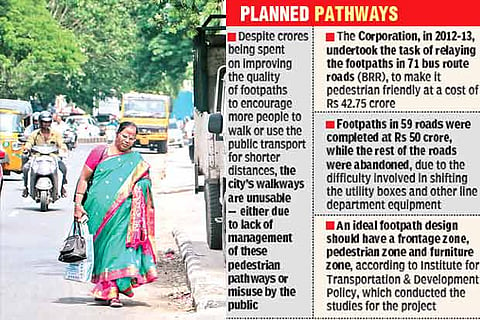

Chennai
In 2012-2013, the Greater Chennai Corporation took up creating the pedestrian pathways on the pavements on 71 bus route roads, running to a length of 48.60 km, at a cost of Rs 42.5 crore.
The civic body would widen the footpaths from 1.5m to 3m and add features such as bollards, to discourage two- and four-wheelers from being parked on the pavements meant for pedestrians. The footpath design was to include a frontage zone (space for storefront activity), a pedestrian zone (space for walking) and a furniture zone (for street furniture such as manholes, trees and utility boxes), suggested by Institute for Transportation and Development Policy (ITDP), which conducted the studies for the project.
A senior Corporation official said, “Out of the 71 roads undertaken, we completed 59 bus route roads at a cost of Rs 50 crore. However, the rest of the roads could not be completed due to the complexities involved in shifting the utilities.”
According to Advait Jani, Program Coordinator – Chennai, Urban Works Institute (UWI), supported by ITDP, an ideal footpath design, “Should include continuous pedestrian space, organised parking and vending, which is a reality in our streets. The footpath should be continuous, starting and ending at the same height. In Greenways Road, for example, there is a beautiful pavement but because it is not continuous, people hardly use it, as they have to keep climbing up and down.
The footpath should be wide enough to accommodate people and should be designed keeping the traffic in mind.”
A walk across a heavily crowded area such as Pondy Bazaar in T Nagar and thoroughfares in Teynampet, Purasaiwalkam and many other parts of the city, revealed footpaths being used as a parking space and broken bollards were a common feature.
“We need a parking management system, as footpath and streets are encroached by vehicles as parking spaces. There is zero enforcement,” added Advait.
The civic body adopted the Non-Motorised Transport (NMT) policy in 2014, “to increase the use of cycling and walking by creating a safe and pleasant NMT network of footpaths, cycle tracks, greenways, and other facilities to serve all citizens in the COC (Corporation of Chennai) area.
Future plans
The Corporation has plans to implement pedestrian friendly footpaths in all the 480 plus bus route roads, in a phased manner. “For this to be done, an in-depth study should be conducted on the pedestrian density, vehicle flow and other such criteria.
The Corporation is planning to include ducting in the footpaths, which will provide separate ducts for service utilities. This is thrice the cost of laying the footpath. We need around Rs 500 crores to ensure pavements in bus route roads are redesigned.
We hope to take this up under the Smart City funding. However, the project will be done in phases, as per fund availability,” said the Corporation official.
While the footpaths are being redesigned, not only the pedestrians but also the street vendors should be factored in, pointed Satyarupa Sekhar, Director, Government Outreach and Advocacy, Citizen Consumer and Civic Action Group (CAG), which conducted a survey for the Corporation before the implementation of the second phase of footpath redesign project. “The footpath design should also include the street vendors, who are a part of Indian streets. When we conducted our survey, we realised that these vendors had a symbiotic relationship with their surroundings. For example, if a road is dotted with garment shops, the vendors will sell accessories such as bangles and earrings. They are an important part of our streets, from a security perspective. We need to look at how we can accommodate street vendors into the design, while planning our footpaths,” she said.
Visit news.dtnext.in to explore our interactive epaper!
Download the DT Next app for more exciting features!
Click here for iOS
Click here for Android